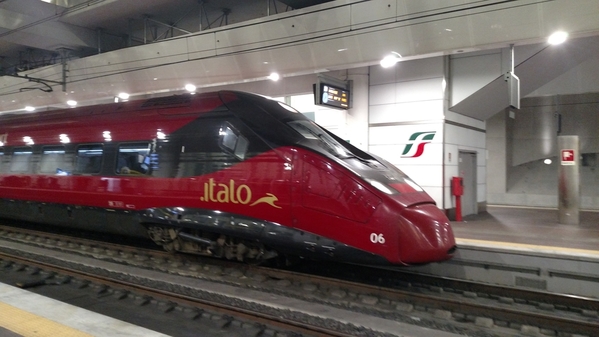My wife and I just returned from a three-week trip to Italy (our first) – lots of good food, lots of walking to/from and within museums, lots of people (Vatican Museum felt like NYC subways at rush-hour) and some travel on Italian high-speed trains (hence this post).
There are two main passenger railroads in Italy – the state-owned Trenitalia and the relatively new (2012) Italo, privately owned by Nuovo Trasporto Viaggiatori (NTV). Trenitalia’s service network is more extensive – and has regional trains as well as two flavors of high-speed trains - Frecciarossa and Frecciargento (red and silver arrow, respectively). Italo has a more limited network and is apparently the first ‘open access’ high-speed rail operator in the world.
The first of our three train trips was from Rome (Termini) to Venice (Santa Lucia) on Italo. The trainset was an ETR 675 – made by Alstom (also maker of the French TGV) – and consisted of 7 cars. This is the newer of the two trainsets built for Italo and is referred to by Alstom as the Avelia Evo – capable of 250 km/h (155 mph). A similar trainset by Alstom, the Avelia Liberty has been selected by AMTRAK as the replacement for the Acela. Unlike the Liberty, the Evo trainset has distributed power, with cars 1,2 and 6,7 powered (total of 5.6 MW). Italo has four coach classes (they call them ‘ambiences’), Smart (four seats in a row in 2 x 2 seating), Comfort (3 seats in a row, 1 x 2 seating), Prima (same as Comfort but with in-car beverage service) and Executive Club, also 1 x 2 seating but with wider seats and personal TV monitors.
ETR-675 (Alstom)
We were able to get Senior fares – a 40% discount off the Prima seating price. So our one-way trip from Rome to Venice cost 54 Euros each (~$60) – not bad for a 3 hr, 45 min trip of ~500 km (average speed = 83 mph) Highest speed was 247 km/h (153 mph). Very smooth, quiet ride. Just as a comparison, the Acela from NY Penn to DC costs $173 each (no senior discount available on Acela) and takes ~3 hr to go 226 miles (= 75 mph average)
Our second trip was from Venice to Florence on Trenitalia’s Frecciarossa. This trainset, built by Bombardier in consortium with several Italian companies, was the new ETR 1000, which is supposedly capable of 400 km/h speeds, but is restricted to 300 km/h by the current upper limit in the Italian high-speed corridors. The ETR 1000 is 8 cars with 9.8 MW of distributed power. Like the Italo trainsets, this one also has four classes of service – we rode in the ‘standard’ class (40 Euros ~ $50 each), which is 2 x 2 seating – typically four seats around a center table. The high-speed stretch between Bologna and Florence – 79 km – is mostly tunnels (74 km).
ETR1000 (Bombardier)
Several days later we returned to Rome via an Italo ETR 575 trainset – also built by Alstom – the AGV (Automotrice à grande vitesse) is apparently a design successor to the TGV. It is longer (11 cars) and faster (spec’d at 360 km/h) than the ETR 675. Interestingly, it requires only 7.6 MW of distributed power – apparently due in part to its articulated design with adjacent cars sharing a common bogie. The Florence-Rome trackage is the fastest of our trip – 261 km in 1.5 hr; we hit 260 km/h (=162 mph) and had sustained speeds of 250 km/h or higher for ~50 min of the trip. We paid 40 Euros each for Executive Club seats, which are reminiscent of the ‘older’ business class seats on US airlines (recline but don’t lie flat). Very comfortable.
ETR-575 (Alstom) - top - and Club seating - bottom
Overall, the trains were comfortable, clean, quiet, fast and close to on-schedule. The only negative was the lack of adequate storage for luggage. There is above-seat storage, but with limited height (basically luggage no ‘thicker’ than an airline carry-on). The size of luggage that seems to be in vogue these days (equivalent to small-to-medium size refrigerators!) – often with more than one per person – filled up the very small luggage rack at the end of the car (when present) very quickly. The prices seemed reasonable – apparently the entrance of NTV into the Italian railroad passenger market has reduced prices and improved service. And there are multiple trains per day on any of the lines we were interested in – for example, Italo (NTV) has fast trains every 30 min from Rome to Florence from ~5 am to 9 pm (many of those are through trains from Naples to Milan or Naples to Venice). One final technical note: none of the trainsets we rode on tilt, although according to the Alstom information the ETR 675 is based on a Pendolino design, but it is still non-tilting… And one more final note – both Italo and Trenitalia have English websites where we bought our tickets in advance. The fast trains require advanced ticketing and you have assigned seats.















